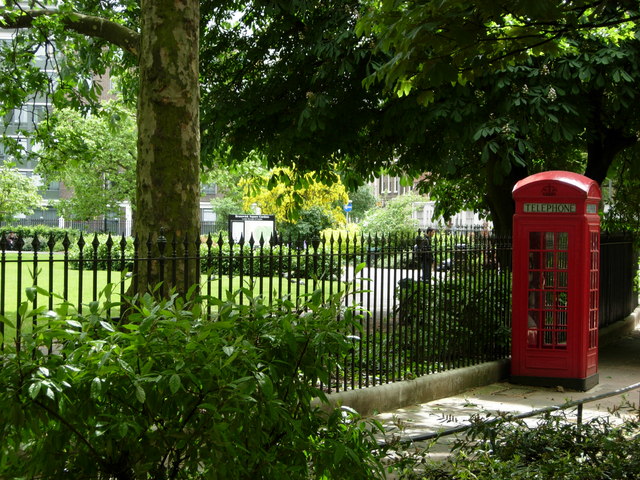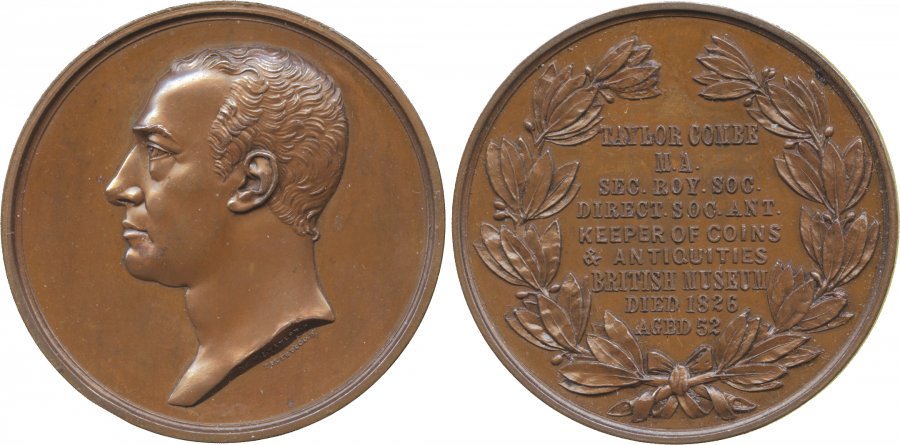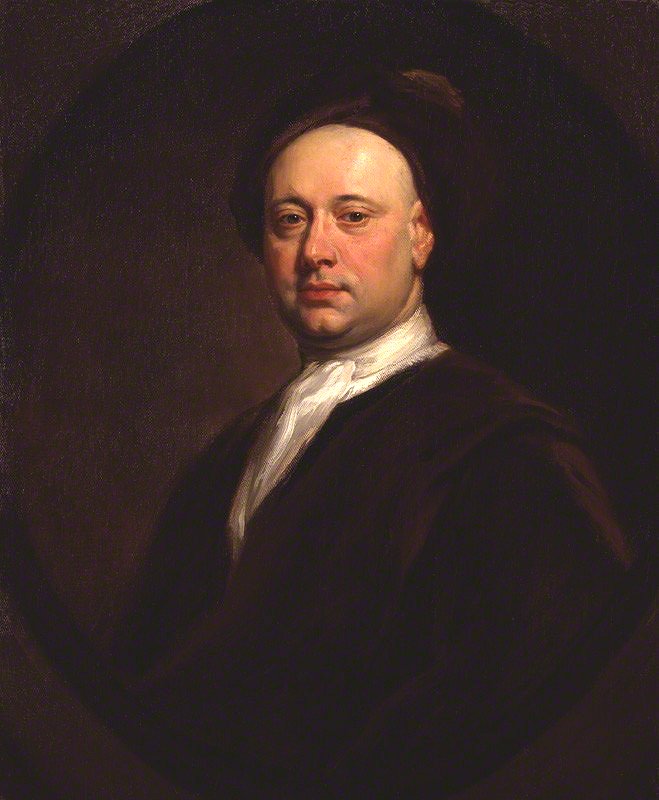|
Charles Combe
Charles Combe FRS M.D. (1743–1817) was an English physician and numismatist. Life He was born on 23 September 1743, in Southampton Street, Bloomsbury, London where his father, John Combe, carried on business as an apothecary. He was educated at Harrow School, and among his schoolfellows were Sir William Jones and Samuel Parr. He rose to the sixth form, but did not proceed to university. Coming to London, he studied medicine, and on his father's death in 1768 succeeded to his business. In 1783 the degree of doctor of medicine was conferred on him by the University of Glasgow, and he began to practise as an obstetric physician. On 5 April 1784 he was admitted by the Royal College of Physicians a licentiate in midwifery; on 30 June he was nominated a governor of St. Bartholomew's Hospital. In 1789 he was chosen physician to the British Lying-In Hospital in Brownlow Street, and on resigning the post in 1810 was appointed consulting physician to the institution. He had also a sub ... [...More Info...] [...Related Items...] OR: [Wikipedia] [Google] [Baidu] |
Fellow Of The Royal Society
Fellowship of the Royal Society (FRS, ForMemRS and HonFRS) is an award granted by the judges of the Royal Society of London to individuals who have made a "substantial contribution to the improvement of natural science, natural knowledge, including mathematics, engineering science, and medical science". Fellow, Fellowship of the Society, the oldest known scientific academy in continuous existence, is a significant honour. It has been awarded to many eminent scientists throughout history, including Isaac Newton (1672), Michael Faraday (1824), Charles Darwin (1839), Ernest Rutherford (1903), Srinivasa Ramanujan (1918), Albert Einstein (1921), Paul Dirac (1930), Winston Churchill (1941), Subrahmanyan Chandrasekhar (1944), Dorothy Hodgkin (1947), Alan Turing (1951), Lise Meitner (1955) and Francis Crick (1959). More recently, fellowship has been awarded to Stephen Hawking (1974), David Attenborough (1983), Tim Hunt (1991), Elizabeth Blackburn (1992), Tim Berners-Lee (2001), Venki R ... [...More Info...] [...Related Items...] OR: [Wikipedia] [Google] [Baidu] |
Brunswick Square
Brunswick Square is a public garden and ancillary streets along two of its sides in Bloomsbury, in the London Borough of Camden. It is overlooked by the School of Pharmacy and the Foundling Museum to the north; the Brunswick Centre to the west; and International Hall (a hall of residence of the University of London) to the south. East is an enclosed area of playgrounds with further trees, Coram's Fields, associated with charity Coram Family which is just over double its size; next to that area Brunswick Square is mirrored, symmetrically by Mecklenburgh Square, likewise of 3 acres including roads. The squares are named after contemporary Queen consorts (the wife of George III and the wife of his eldest son George IV). Layout Bloomsbury is notable for its garden squares, literary connections, and numerous cultural, educational and health care institutions. Mecklenburgh Square is a matching square to the east covering three acres. Between the two, east of this sq ... [...More Info...] [...Related Items...] OR: [Wikipedia] [Google] [Baidu] |
1817 Deaths
Events January–March * January 1 – Sailing through the Sandwich Islands, Otto von Kotzebue discovers New Year Island. * January 19 – An army of 5,423 soldiers, led by General José de San Martín, starts crossing the Andes from Argentina, to liberate Chile and then Peru. * January 20 – Ram Mohan Roy and David Hare found Hindu College, Calcutta, offering instructions in Western languages and subjects. * February 12 – Battle of Chacabuco: The Argentine–Chilean patriotic army defeats the Spanish. * March 3 ** President James Madison vetoes John C. Calhoun's Bonus Bill. ** The U.S. Congress passes a law to split the Mississippi Territory, after Mississippi drafts a constitution, creating the Alabama Territory, effective in August. * March 4 – James Monroe is sworn in as the fifth President of the United States. * March 21 – The flag of the Pernambucan Revolt is publicly blessed by the dean of Recife Cathedral, Brazil. ... [...More Info...] [...Related Items...] OR: [Wikipedia] [Google] [Baidu] |
1743 Births
Events January–March * January 1 – The Verendrye brothers, probably Louis-Joseph and François de La Vérendrye, become the first white people to see the Rocky Mountains from the eastern side (the Spanish conquistadors had seen the Rockies from the west side). * January 8 – King Augustus III of Poland, acting in his capacity as Elector of Saxony, signs an agreement with Austria, pledging help in war in return for part of Silesia to be conveyed to Saxony. * January 12 ** The Verendryes, and two members of the Mandan Indian tribe, reach the foot of the mountains, near the site of what is now Helena, Montana. ** An earthquake strikes the Philippines * January 16 –Cardinal André-Hercule de Fleury turns his effects over to King Louis XV of France, 13 days before his death on January 29. * January 23 –With mediation by France, Sweden and Russia begin peace negotiations at Åbo to end the Russo-Swedish War. By August 17, Sweden cedes all ... [...More Info...] [...Related Items...] OR: [Wikipedia] [Google] [Baidu] |
Taylor Combe
Taylor Combe FRS (1774 – 7 July 1826) was an English numismatist and archæologist. Life He was the eldest son of Dr. Charles Combe, the physician and numismatist. He was educated at Harrow School and at Oriel College, Oxford, where he graduated B.A. on 5 June 1795, M.A. 10 July 1798. In 1803, he obtained an appointment in the British Museum, and superintended the collection of coins and medals. In 1807, he became keeper of the department of antiquities, the coins still remaining in his charge. In 1814, he was sent to Zante, to carry out the purchase of the Phigaleian marbles. Combe was elected a Fellow of the Royal Society in 1806, and was secretary to it from 1812 to 1824, during which period he edited the ''Philosophical Transactions''. He joined the Society of Antiquaries of London in 1796, became its director in 1813, and superintended the publication of the later portions of the ''Vetusta Monumenta''. He contributed many articles to '' Archæologia''. Combe held h ... [...More Info...] [...Related Items...] OR: [Wikipedia] [Google] [Baidu] |
British Museum
The British Museum is a public museum dedicated to human history, art and culture located in the Bloomsbury area of London. Its permanent collection of eight million works is among the largest and most comprehensive in existence. It documents the story of human culture from its beginnings to the present.Among the national museums in London, sculpture and decorative and applied art are in the Victoria and Albert Museum; the British Museum houses earlier art, non-Western art, prints and drawings. The National Gallery holds the national collection of Western European art to about 1900, while art of the 20th century on is at Tate Modern. Tate Britain holds British Art from 1500 onwards. Books, manuscripts and many works on paper are in the British Library. There are significant overlaps between the coverage of the various collections. The British Museum was the first public national museum to cover all fields of knowledge. The museum was established in 1753, largely b ... [...More Info...] [...Related Items...] OR: [Wikipedia] [Google] [Baidu] |
George Vertue
George Vertue (1684 – 24 July 1756) was an English engraver and antiquary, whose notebooks on British art of the first half of the 18th century are a valuable source for the period. Life Vertue was born in 1684 in St Martin-in-the-Fields, London, his father, perhaps a tailor, and mother are noted as 'Roman Catholic'. At the age of 13, he was apprenticed to a prominent heraldic engraver of French origin who became bankrupt and returned to France. Vertue worked seven years under Michael Vandergucht, before operating independently. He was amongst the first members of Godfrey Kneller's London Academy of Painting, who had employed him to engrave portraits. citing: Walpole's ''Anecdotes of Painting''; Nichols's ''Literary Anecdotes'', ii. 246; Chester's ''Westminster Abbey Reg.''; Dodd's manuscript ''Hist. of English Engravers'' in Brit. Mus. (Addit. MS. 33406). It was there that he became a pupil of Thomas Gibson, a leading portrait painter. Vertue had a deep interest in antiqu ... [...More Info...] [...Related Items...] OR: [Wikipedia] [Google] [Baidu] |
Richard Southgate (clergyman)
Richard Southgate (1729–1795) was an English clergyman and numismatist. Life Born at Alwalton, Huntingdonshire, a few miles from Peterborough, on 16 March 1729, he was the eldest of ten children of William Southgate (d. February 1771), a farmer of the parish, who married Hannah (d. 1772), daughter of Robert Wright of Castor, Northamptonshire, a surveyor and civil engineer. He was educated at private schools at Uppingham and Fotheringay and at the Peterborough grammar school. With an exhibition from the school he went to St John's College, Cambridge, in 1745, and graduated B.A. in the Easter term of 1749. Southgate took holy orders in 1752, and, after serving the curacy of Weston, Lincolnshire, held the rectory of Woolley, Huntingdonshire from 8 November 1754 till 1759. From 1759 to 1763 he served numerous curacies in Lincolnshire, but on 9 January 1763, for the sake of literary society, he accepted the curacy of St James's, Westminster, which he retained until the end of 1765. ... [...More Info...] [...Related Items...] OR: [Wikipedia] [Google] [Baidu] |
British Critic
The ''British Critic: A New Review'' was a quarterly publication, established in 1793 as a conservative and high-church review journal riding the tide of British reaction against the French Revolution. The headquarters was in London. The journal ended publication in 1843. High-church review The Society for the Reformation of Principles, founded in 1792 by William Jones of Nayland and William Stevens, established the ''British Critic'' in 1793. Robert Nares and William Beloe, editor and assistant editor respectively, were joint proprietors with the booksellers and publishers Francis and Charles Rivington. It was started as a monthly, but in 1825 its frequency was shifted to quarterly. Nares and Beloe edited the review for about 20 years. Around 1811 the magazine was bought by Joshua Watson and Henry Handley Norris, associated with the high-church pressure group known as the Hackney Phalanx. After 1825 the review "became more narrowly theological in scope". Tractarian takeover ... [...More Info...] [...Related Items...] OR: [Wikipedia] [Google] [Baidu] |
Variorum
A variorum, short for ''(editio) cum notis variorum'', is a work that collates all known variants of a text. It is a work of textual criticism, whereby all variations and emendations are set side by side so that a reader can track how textual decisions have been made in the preparation of a text for publication. The Bible and the works of William Shakespeare have often been the subjects of variorum editions, although the same techniques have been applied with less frequency to many other works. Etymology The word ''variorum'' is Latin for 'of various ersons and derives from the phrase ''cum notis variorum'' ('with notes by various people') which was often used in the title-pages of Dutch books of the 17th century. Original meaning An older meaning of the word refers not to the text itself but to the assortment of illustrative notes printed with it: 'an edition of a text (usually Latin or Greek) which includes annotations by a variety of critics and commentators'. Variorum editio ... [...More Info...] [...Related Items...] OR: [Wikipedia] [Google] [Baidu] |
Horace
Quintus Horatius Flaccus (; 8 December 65 – 27 November 8 BC), known in the English-speaking world as Horace (), was the leading Roman lyric poet during the time of Augustus (also known as Octavian). The rhetorician Quintilian regarded his ''Odes'' as just about the only Latin lyrics worth reading: "He can be lofty sometimes, yet he is also full of charm and grace, versatile in his figures, and felicitously daring in his choice of words."Quintilian 10.1.96. The only other lyrical poet Quintilian thought comparable with Horace was the now obscure poet/metrical theorist, Caesius Bassus (R. Tarrant, ''Ancient Receptions of Horace'', 280) Horace also crafted elegant hexameter verses (''Satires'' and '' Epistles'') and caustic iambic poetry ('' Epodes''). The hexameters are amusing yet serious works, friendly in tone, leading the ancient satirist Persius to comment: "as his friend laughs, Horace slyly puts his finger on his every fault; once let in, he plays about the heartstrin ... [...More Info...] [...Related Items...] OR: [Wikipedia] [Google] [Baidu] |
Emmanuel College, Cambridge
Emmanuel College is a constituent college of the University of Cambridge. The college was founded in 1584 by Sir Walter Mildmay, Chancellor of the Exchequer to Elizabeth I. The site on which the college sits was once a priory for Dominican monks, and the College Hall is built on the foundations of the monastery's nave. Emmanuel is one of the 16 "old colleges", which were founded before the 17th century. Emmanuel today is one of the larger Cambridge colleges; it has around 500 undergraduates, reading almost every subject taught within the University, and over 150 postgraduates. Among Emmanuel's notable alumni are Thomas Young, John Harvard, Graham Chapman and Sebastian Faulks. Three members of Emmanuel College have received Nobel Prizes: Ronald Norrish, George Porter (both Chemistry, 1967) and Frederick Hopkins (Medicine, 1929). In every year from 1998 until 2016, Emmanuel was among the top five colleges in the Tompkins Table, which ranks colleges according to end-of-year ex ... [...More Info...] [...Related Items...] OR: [Wikipedia] [Google] [Baidu] |







.png)

